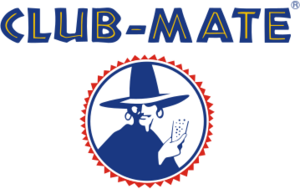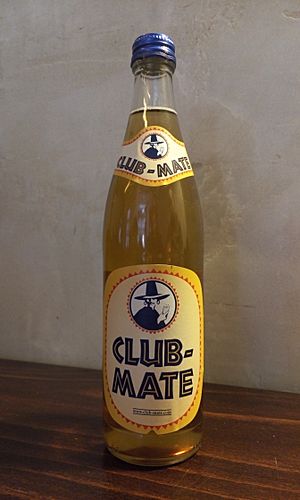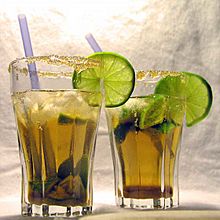Club-Mate facts for kids
 |
|
 |
|
| Country of origin | Germany |
|---|---|
| Introduced | 1924 |
Club-Mate is a popular drink from Germany. It's a carbonated (bubbly) beverage made from mate tea extract. It has caffeine in it, which gives you a little energy boost.
Club-Mate was first made in 1924 by the Loscher Brewery. It has less sugar and caffeine than many other energy drinks. You can find Club-Mate in 0.33-litre and 0.5-litre bottles.
Some bottles have a German slogan that means "you'll get used to it." People often mix Club-Mate with other drinks to create new flavors.
Contents
The Story of Club-Mate
How Club-Mate Started
Club-Mate was first created in 1924 by a company called Geola Beverages. Back then, it was known as Sekt-Bronte. For many years, it was only popular in its local area in Germany.
In 1994, the Loscher Brewery bought the drink. They changed its name to Club-Mate and started selling it more widely. This helped Club-Mate become much more famous.
New Flavors Over Time
Over the years, Club-Mate has introduced different versions of its drink:
- In 2007, a special Club-Mate Winter Edition was released. It had extra spices like cardamom and cinnamon, giving it a warm, festive taste. This special edition is now sold every winter.
- In 2009, a Club-Mate cola was launched. Unlike other colas, it also included mate extract in its recipe.
- In 2013, Club-Mate Granat came out. This version had an added pomegranate flavor, making it taste more fruity.
- In April 2022, Club-Mate Zero became available. This is a sugar-free version of the classic drink.
By 2010, Club-Mate was being sold in over 60 countries around the world. This included places like the United States, Canada, Australia, and the United Kingdom.
Club-Mate and Culture
Club-Mate has become very popular in certain communities. It's especially well-liked among people interested in computers and technology. Many tech companies and computer hacker groups in Europe enjoy Club-Mate.
Famous writer Bruce Sterling even mentioned that it's a favorite drink of Germany's Chaos Computer Club. It's also popular at big tech events and festivals around the world. These events include HOPE in the U.S. and Electromagnetic Field in the UK.
Because of its popularity in these groups, Club-Mate has been featured in many online articles and magazines. It's also a favorite drink among people who go to electronic music parties in cities like Berlin.
What's in Club-Mate?
Main Ingredients
Club-Mate is made with several ingredients that give it its unique taste and energy boost:
- Water
- Inverted sugar syrup (a type of sugar)
- Sugar
- Mate tea extract (the main flavor)
- Citric acid (for a tart taste)
- Caffeine (for energy)
- Natural flavors
- Caramel color (for its brown color)
- Carbonic acid (to make it bubbly)
Different Club-Mate Drinks
Besides the original, there are a few other Club-Mate drinks you can try:
- Club-Mate IceT Kraftstoff is an iced tea version. It has a bit more caffeine and sugar than the original.
- Club-Mate Granat has added pomegranate for a fruity flavor.
- Club-Mate Winter Edition includes spices, giving it a taste similar to gingerbread. This one is only sold during the winter months.
- Club-Mate Zero is the newest option, offering a sugar-free choice.
Tschunk: A Mixed Drink
| Cocktail | |
|---|---|
 |
|
| Type | Highball |
| Primary alcohol by volume | |
| Commonly used ingredients |
|
| Preparation | Dice limes, put them together with the brown sugar into a high glass and crush both. Add crushed ice and pour the rum and the Club-Mate over it. Add a straw |
Tschunk is a popular mixed drink that uses Club-Mate. It's a German highball drink, which means it's a mix of a spirit and a larger amount of a non-alcoholic mixer. Tschunk is typically made with Club-Mate and a type of spirit, often served with limes and brown sugar.
Like Club-Mate itself, Tschunk is very common in European tech and hacker communities. You can often find it at events like the Chaos Communication Congress. One journalist, Vernon Silver, once said about Tschunk, "It tastes a lot better than it sounds."
Other Mate Drinks
- Materva: A bubbly mate-based drink from Cuba.
- Nativa: Another carbonated mate drink, made by the Coca-Cola Company.
See also
 In Spanish: Club-Mate para niños
In Spanish: Club-Mate para niños

